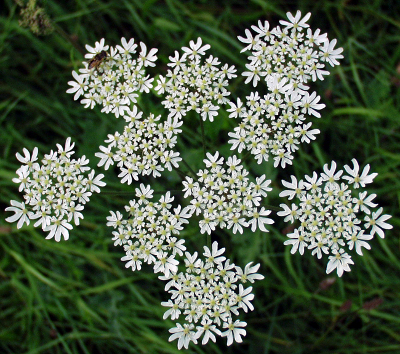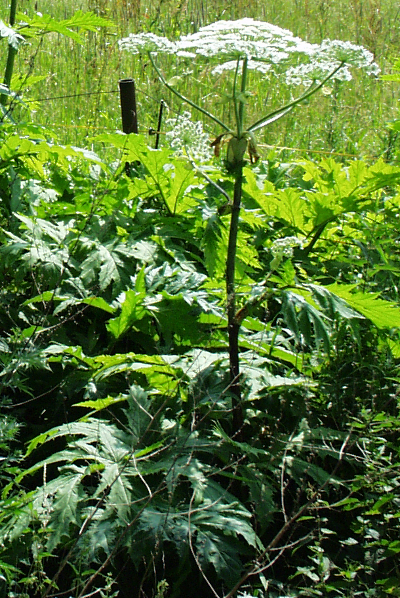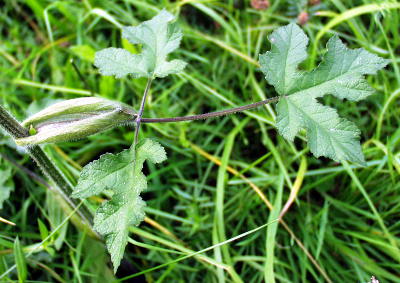Heracleum, hogweed |

Inflorescence of the eltrot

Giant hogweed

Upper
stem leaf of the eltrot. The greatly broadened petiole
clasps
the stem
The species mentioned by Pliny literally Heracleum do not belong to the celery family, but are species of gromwell (Lithospermum) and water lilies (Nymphaea). Only his Spondylion can be assigned to the hogweeds. The English name means that the roots are eaten by hogs or that the plants are only good as hog feed.
With some 70 species, the genus whose main distribution area is Eurasia and East Africa consists of perennial, hairy herbs, often with taproot. The erect stems are in cross-section circular, ribbed, hollow or solid and often branched. The stalked leaves are simple, pinnate or pinnatipartite, hairy or glabrous and clasp the stem usually with fairly broad leaf sheath.
The inflorescences (double umbels or umbels of higher order) are arranged lateral and terminal, the latter bears usually hermaphroditic flowers, the lateral often male ones. The bracts of the umbel, the so-called involucre, is missing or has only a few leaves. The 3- to many-rayed umbel shows loosely composed umbellules which bears white, yellow or pink flowers whose marginal petals are more or less enlarged. The bracts of the umbellule form the involucel, which consists of some linear, lance-shaped or oval leaves. The calyx teeth are triangular to lanceolate or they are very small and hardly to recognize. The petals are notched at the apex and shortly bent inward.
After insect or self-pollination the inferior ovary forms ovate to roundish, strongly flattened fruits with 10 ribs. They are composed of 2 meriarps with 5 ribs, their lateral ribs are usually winged. The 3 ribs on the back are either obviously or hardly developed. Between the ribs there are 4 darker oil tubes.
| Floral formula mostly: |
| * K5 C5 A5 G(2) inferior |
Historical publications
Theophrastus (371–287 B.C.) wrote, the "heraclic Panakes" possesses large, broad leaves and finger-thick roots. The aroma resembles the frankincense. Together with the lab-ferment of seals, it helps to treat epilepsy.
Pliny (about 23–79. AD.) reported on the Spondylion, it would resemble the Panax, but possessed smaller leaves that resembled the plane (Platanus) and would grow well in the shade. The seeds were similar to that of the the Seseli. An infusion of it, which is poured over the head, heal madness, somnolence and headache. Internally it can be mixed with old vegetable oil, which would act against epilepsy, jaundice and constipation. As ointment rubbed into the hair, it would make curls.
Dioscorides (1st century AD.) wrote similarly over the Sphondylion, but mentioned also that it had umbels at the top and would resemble the fennel.
Leonhart Fuchs (1501–1566) described the plant as "Bernklaw" or "Berentatz" (= bear paw). In pharmacies it would be called Branca ursina. In his chapter, he reports on two races of the plant. With the first race but he means no hogweed, but Acanthus mollis and refers to Pliny, who described two different types of Acanthus: a spiny and a curly one. Today it is believed that by the spiny plant really Acanthus mollis was meant and by the second one Bupleurum lancifolium and not, as assumed by Fuchs, the eltrot.
Meaning of the species names
- mantegazzianum: according to the physician, naturalist and anthropologist Paolo Mantegazza (1831–1910), who dealt among other things with this plant.
- sphondylium: according to Plinys and Dioscorides' Spondylion or Sphondylion.
Interesting notes
-
Hogweed species may cause blisters on the skin, similar to a burn. They develop after touching the plant and under sun exposure.
The giant hogweed (Heracleum mantegazzianum) is a very large ornamental plant, originating from the Caucasus. In Europe it formed feral populations and is considered invasive neophyte.
The seeds of Golpar, a native of Iran Heracleum species, are used in the local cuisine as a spice.